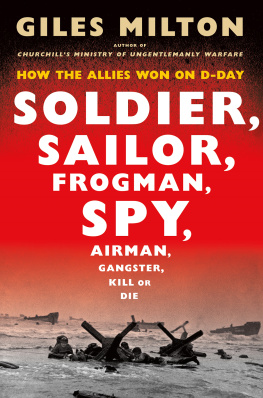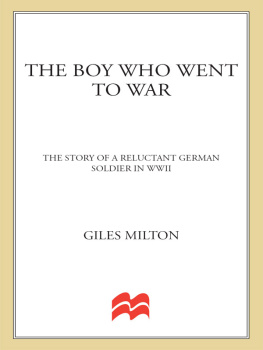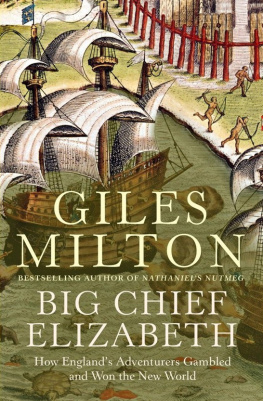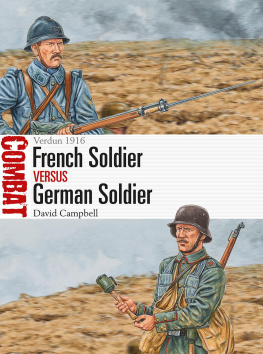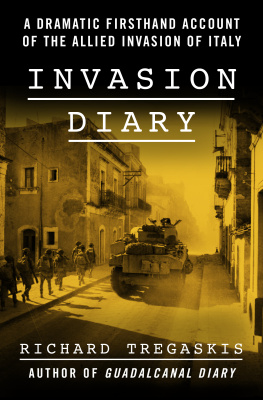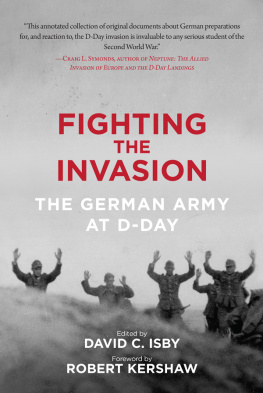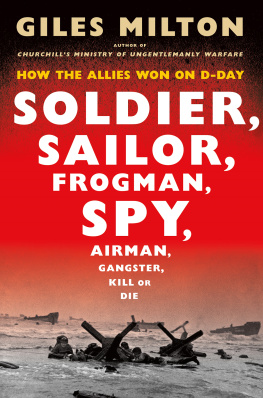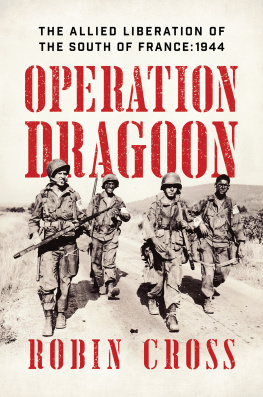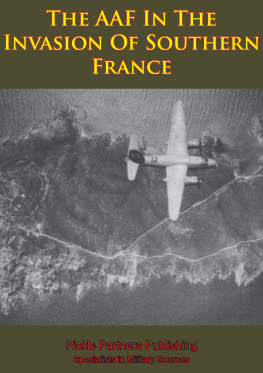Contents
Guide
GILES MILTON
HOW THE ALLIES WON ON D-DAY
SOLDIER,
SAILOR,
FROGMAN,
SPY,
AIRMAN,
GANGSTER,
KILL OR
DIE
Henry Holt and Company
New York
The author and publisher have provided this e-book to you for your personal use only. You may not make this e-book publicly available in any way. Copyright infringement is against the law. If you believe the copy of this e-book you are reading infringes on the authors copyright, please notify the publisher at: http://us.macmillanusa.com/piracy.
To all who served
I want to tell you what the opening of the second front entailed, so that you can know and appreciate and forever be humbly grateful to those both dead and alive who did it for you.
Ernie Pyle, war correspondent
T HE LIBERATION OF occupied Europe had been the Allied goal ever since the evacuation of Dunkirk in May 1940, when 330,000 beleaguered troops were rescued from the advancing Wehrmacht. But the early years of war had dealt the Allies such a string of crushing defeats that any talk of a cross-Channel offensive was wishful thinking. Although Hitler had cancelled his planned invasion of Britain in the autumn of 1940, his forces in North Africa and Russia had swept from victory to victory.
By the winter of 1942 the tide had begun to turn. In Russia, German forces were trapped at Stalingrad and would soon surrender a humiliating defeat for the Wehrmacht. In North Africa, the British Eighth Army had beaten the enemy at El Alamein. And in the Pacific theatre, the Americans who had entered the war after the Japanese attack on Pearl Harbor in December 1941 were making significant gains.
The tide was also turning in the North Atlantic, where German U-boats were being successfully targeted by heavily armed Atlantic convoys. By the late spring of 1943, Admiral Karl Dnitz would admit to having lost the Battle of the Atlantic. It was a costly loss, for it would enable large numbers of American troops and supplies to pour into Britain.
At the Casablanca Conference in January of that year, President Franklin Roosevelt had persuaded a reluctant Winston Churchill to establish a new Allied planning staff: its role was to prepare for an invasion of occupied France. The top job went to Lieutenant General Frederick Morgan, who was given a ten-word brief: to defeat the German fighting forces in North-West Europe.
The formal decision to press ahead with this cross-Channel invasion was taken by Churchill and Roosevelt at the Trident Conference in the spring of 1943, by which time Morgans staff had increased dramatically. Yet it was not until December that General Dwight Eisenhower was appointed Supreme Allied Commander, with General Bernard Montgomery as commander of the 21st Army Group, comprising all land forces earmarked for the invasion. The organization hitherto led by Morgan was renamed: henceforth, it was to be known as Supreme Headquarters Allied Expeditionary Force (SHAEF), with its headquarters at Norfolk House in London. In March 1944 it moved to Bushy Park, west London, with an advance headquarters at Southwick House in Portsmouth. Eisenhowers staff numbered more than 900.
Morgan had envisaged an amphibious landing of three divisions. Allied troops would assault the gently shelving beaches of Normandy, where the coastal defences were weaker than at the Pas de Calais. But Eisenhower and Montgomery both felt that Morgans troop numbers were too small; they added two more divisions to the planned invasion now codenamed Operation Overlord along with a major airborne component. They also expanded the landing zone to cover fully sixty miles of Normandy coastline, stretching from Sainte-Mre-glise to Lion-sur-Mer.
Some 156,000 soldiers were to assault five D-Day beaches: Utah, Omaha, Gold, Juno and Sword. The first two were assigned to the Americans, Juno to the Canadians and Gold and Sword to the British.
The goal for the invasion day was ambitious: a near contiguous beachhead stretching along much of Normandys coast, with only a small gap between Utah and Omaha beaches. It was to extend fifteen miles inland and was to include the cities of Caen and Bayeux.
The imperative was to secure the coastal landing zone. First, there would be an intense pre-dawn bombardment from the air to obliterate the German coastal defences. This would be followed by a big-gun naval attack, with smaller rocket ships providing additional firepower. Next, an army of amphibious tanks would emerge from the sea and blast away any remaining guns. Specialist tanks would follow, along with armoured bulldozers. Then, once passages had been cleared through the beach debris in the opening hours of the first day, large numbers of infantry troops would be landed, followed by thousands of tons of supplies.
The logistical challenge was unprecedented. The number of American troops stationed in England had risen to 1.5 million by spring 1944, fully twenty divisions. There were also fourteen British divisions, three Canadian, one French and one Polish. These troops required thousands of jeeps and armoured vehicles, as well as artillery pieces, shells and ammunition. On D-Day itself, 73,000 American troops would be landed in Normandy, along with 62,000 British and 21,000 Canadian.
Secrecy and deception were to be of paramount importance to the operations success: the Allies intended to dupe the Germans into thinking they would be landing at the Pas de Calais. To this end, they mounted Operation Fortitude, complete with phantom field armies, fake wireless traffic and the brilliant use of double agents working under the Double Cross System, whereby captured Nazi spies transmitted false intelligence back to Germany.
The commando raid on Dieppe (August 1942), the invasion of Sicily (July 1943) and the landings in Italy two months later gave a taste of the dangers to come. The amphibious landings at Salerno had faced stubborn resistance from German panzers, while those at Anzio came close to disaster. Yet Overlord was on a far more ambitious scale. Although the aerial bombardment of German coastal defences was a key ingredient, it was by no means certain that saturation bombing would destroy the coastal bunkers.
An additional concern was the lack of combat experience among Allied forces: many young conscripts had yet to be tested in battle and would require leadership from units that had already seen action. Yet even experienced troops often lacked the fighting spirit of the Germans. In virtually every previous engagement with the enemy wherever the Allies had fought with equal numbers the Wehrmacht had defeated them.
Allied forces would be doing battle against a formidable German military machine. Despite the hammering it was receiving on the Eastern Front, its soldiers displayed extraordinary bravado. Their fighting spirit was supported by superb weaponry. The Wehrmachts Panther and Tiger tanks combined both power and strength: the thinly armoured British Cromwells and American Shermans were simply no match. Nor was Allied infantry weaponry as efficient as its German counterparts. The Wehrmachts MG42 machine gun fired 1,200 rounds per minute; the Allies Bren gun less than half that number.
Hitlers army in France and the Low Countries numbered fifty divisions some 850,000 men with the 15th Army defending the Pas de Calais and the 7th Army defending Normandy. Together they comprised Army Group B, commanded by Field Marshal Erwin Rommel.

